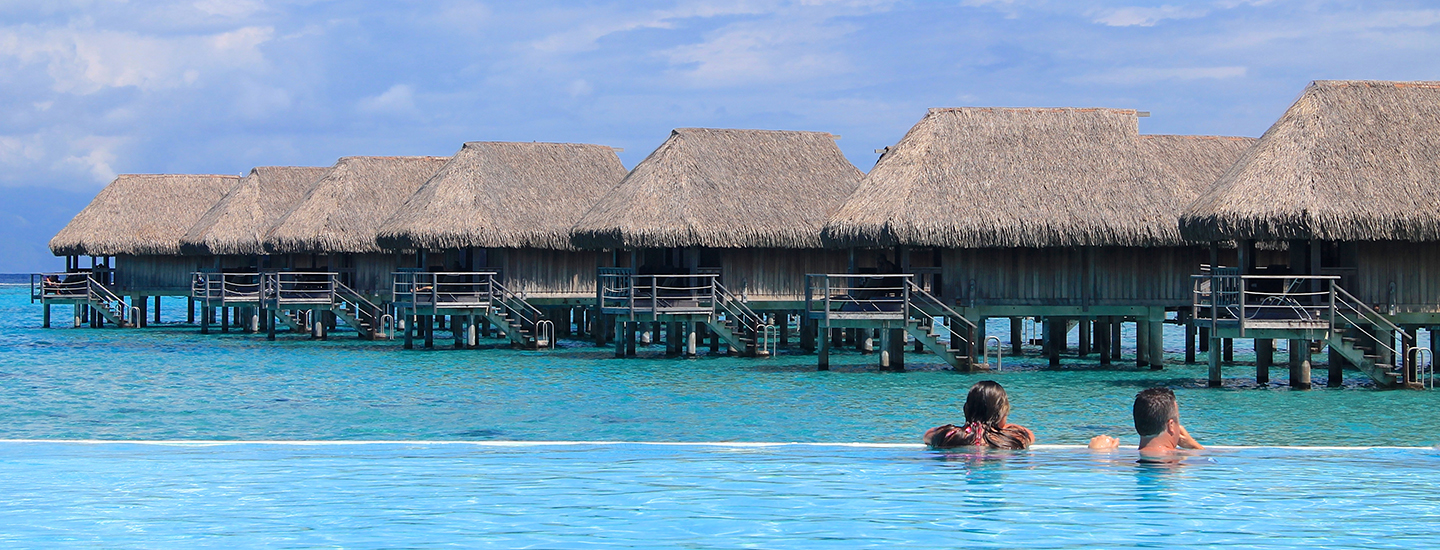


In an age when practically anyone can find a beach to sit on somewhere for a week, privacy is the ultimate luxury. No one knows this better than visitors to French Polynesia.
By Doug Wallace | March 01, 2021
The isolation is the attraction—distant, exotic, romantic and unspoiled. After all, this is one of the last places on earth to be settled by humans. The weather comes a close second, with year-round temps averaging at 27º C. The charming French flavour is point number three—from the baguettes tucked under everyone’s arms in the morning to the double-kissing to the simple yet perfect cuisine. And four? The innovation continuously carried out with regard to keeping the islands both beautiful and sustainable.
Five chains of 118 islands cover a fairly wide swath in the southern Pacific Ocean, spread out over 2,000 kilometres, on about the same latitude as Lima, Peru. The islands are autonomous, yet administered by France as a “collective,” those ties going back to the mid-1800s. Like Hawaii, the biggest island’s name has come to denote the whole region. The capital city of Papeete is your international jumping off point via Air Tahiti Nui, which flies from Los Angeles five times a week.
Leaders in ecotourism innovation.
The 70 inhabited islands are very dependent on tourism and on their lagoons, their main sources of food. As such, protecting them is paramount, which has led to the development of natural marine sanctuaries (including the largest shark sanctuary in the world) and coral restoration programs. Accommodations range from quaint eco-friendly guest houses to luxe eco-hotels that win awards for zero emissions. Many of the big hotels have ecological centres or natural aquariums that protect marine environments while being both educational and entertaining. Some experiment with alternative forms of energy—cool things like solar-powered catamarans, sea-water air conditioning and coconut oil-powered electricity.

Some resorts experiment with cool things like solar-powered catamarans, sea-water air conditioning and coconut oil-powered electricity.
Back to Their Roots
Polynesian culture in general is experiencing a renaissance of sorts, with people now embracing their history and reviving their culture—tattoos included. The islands champion this in a number of ways, with traditional cuisine and entertainment, and with coral nurseries established to encourage reef rejuvenation.
Island-hopping made easy.
Your first stop should be the tranquil island of Moorea, just a half-hour ferry ride north of Papeete. Close enough to the big island but still rather isolated, this is a small community where you will get your first lesson in slowing down—the maximum speed limit is 60 km/hour—and your first taste of the over-water bungalow experience.While they are more expensive, over-water rooms are worth the splurge, larger and more lavish than they look from the outside. Their biggest benefit is the fact that you don’t really have to leave your room, because you can see everything from your deck: the lagoon, the ocean, the beach, the boats. You can even watch the fish swim under your cabin through the window in the floor—when you’re not snorkeling, that is. Just add room service and a good book.
Moorea is famous for its two magnificent bays—Cook’s Bay and Opunohu Bay—with Secret Mountain sitting between them, long considered sacred, the bottom of it ringed with temples and shrines. You’ll also find maraes throughout this and most regions of French Polynesia: stone monuments where the elders of the ancient tribes would come to talk religion, politics and business.
Twenty minutes by plane further north sits Huahine, a two-island grouping, one of the most authentic communities in the region. Unspoiled and more reflective of true Polynesian life, with a history that pre-dates both Hawaii and Fiji, this is the place to learn about the past while immersing yourself in the present. Huahine is a bit of an artist enclave, with a slightly bohemian vibe.
A visit to the museum at Maitai Lapita Village, uncovers the history of the Lapita people, the pre-Polynesian ancestors. Ancient pottery shards from 1500 BC, wooden and whalebone sculptures and tools, tinted engravings, 19th-century photographs, reproductions of war clubs, fishing lures and jewellery—all help illustrate early life here.
The pearl of the Pacific.
The next stop? Bora Bora. With a larger lagoon comes more hotel chains with more over-water bungalows and more people. But that doesn’t take away from the experience, it just makes things a bit more social. Bora Bora is also the most exotically beautiful; shades of aqua too numerous for your eye to properly process, big Mount Otemanu looking down on you, taking everything in. Lagoon cruises will take you out to snorkel coral gardens, feed giant sting rays and swim with black point and lemon sharks—all before sitting down to a barbecued lunch on a private island, picnic tables in the shallow water, ukuleles playing, palm trees swaying.
As for your fellow adventurers, you’ll soon start seeing familiar faces in the airport lounges and get chatting with those that seem to be following you around. In general, this is a well-travelled bunch. Naturally, the French love this place. French families flock here, happy for the easy kinship their passports and common language allows. Mix in the Japanese, Americans and Canadians and you’ve got a melting pot.
When you go.
Peak season is from March to October, with May and June being the driest. Avoid the rainy season, from November to January, when it can rain for three weeks straight.
If your schedule allows, widen your scope to include Tuamotu, really the largest group of atolls in the world; Pangiroa, home to the world’s only coral vineyard; Fakaroua, famous for its amazing diving; or venture out to the Les Marquesas island chain for some real privacy. The domestic airline, Air Tahiti, works its way around all the archipelagos; little 20- and 30-minute flights that give you the complete picture, most for less than $100 one way. Visit TahitiTourisme.com.
